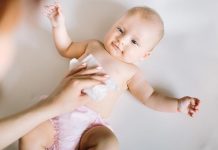Crohn’s disease is a chronic, or long-term illness in which the intestine or bowel becomes inflamed and ulcerated or marked with sores. Along with ulcerative colitis, Crohn’s disease is one of a group of diseases known as inflammatory bowel disease (IBD) which usually affects the lower part of the small intestine, which is called the ileum and can occur in any part of the large or small intestine, stomach, or esophagus. It can even occur in the mouth.
A disorder can happen at any age but children and teens with Crohn’s disease face unique challenges. Crohn’s disease can stunt growth, weaken bones, and delay puberty.
Read More: 21 Foods to avoid with a Crohn’s Disease Diet Plan
A Guide for Crohn’s Disease in Children
Symptoms of Crohn’s disease in children and teens
The experience of your child with Crohn’s disease is determined mainly by the location and extent of the inflammation. Teens and children with the disease have inflammation of the lower part of the ileum and more than half of these children also have inflammation in variable segments of the colon like children have inflammation in the colon only while others have inflammation scattered around the small bowel, mainly in the middle section (jejunum and upper ileum).
In small intestine
Watery diarrhea, abdominal pain, weight loss, appetite loss, and slowed growth. Often the symptoms are very subtle.
Colon
Bloody diarrhea with mucus or pus, cramping abdominal pain, an urgency to defecate (have a bowel movement)
Anus/ Rectum
Painful defecation, rectal bleeding, rectal pain, nausea, vomiting, abdominal pain, poor appetite.
Read More: Mucus in My Child’s Stool: Causes and Natural Remedies
Complications of Crohn’s disease
Undernourishment
People with Crohn’s disease often are undernourished. This happens for several reasons: poor appetite, avoidance of eating because of pain or discomfort, and poor absorption of nutrients by the damaged intestines.
Colon cancer
The threat of colon cancer is increased slightly in people with Crohn’s disease. Cancer usually develops many years after the onset of Crohn’s disease.
Hamper growth and delayed sexual development, or delayed puberty, are common problems in children and teens with Crohn’s disease.
In arthritis
Joint pain is the most common manifestation of Crohn’s disease outside of the intestines. It usually comes and goes and does not deform the joints. It occurs most often in the large joints of the hips and legs and in the spine.
Mouth ulcers
Painful mouth sores may occur during flares of the disease.
Eye problems
Various parts of the eyes can become irritated, inflamed, and painful and this can impair vision.
Unusual blood clotting
People with Crohn’s disease have an increased risk of blood clots forming in the blood vessels.
Read More: Diarrhoea During Pregnancy : Causes, Symptoms and Treatments
Causes of Crohn’s disease
The reason for Crohn’s disease is not known as Crohn’s is an inherited disease that causes an abnormal response of the immune system in the gastrointestinal tract. If you have a relative with Crohn’s disease are more likely to develop the disease in your child and yourself.
Diagnosis of Crohn’s disease
The doctor will review the patient’s medical and family history and various tests are used to diagnose Crohn’s disease, including the following:
- Endoscopy (such as colonoscopy or sigmoidoscopy): During this procedure, a doctor inserts a flexible, lighted tube with a camera in the rectum. The tube and camera together are called an endoscope and colonoscopy show a greater portion of the colon than sigmoidoscopy does.
- Blood tests: When testing the blood, the doctor will look for signs of anemia, or a high white blood cell count which will indicate the inflammation or infection somewhere in the body. The doctor will also perform tests to look for and identify inflammatory markers.
- Barium enema or small bowel series: These procedures use X-rays to examine the upper or lower intestine and barium coats the lining of the small intestine and colon and seen white on an X-ray. This allows the doctor to review any abnormalities.
Treatment and management of Crohn’s disease
The disease can sometimes go into remission on its own so not always possible to determine whether a specific treatment has been effective when Crohn’s disease is active, treatment is aimed at controlling inflammation, correcting nutritional deficiencies, and relieving symptoms such as pain, diarrhea, and fever.
Medications are the first step in treating Crohn’s disease in children and teens. Some of these drugs include anti-inflammatories, antibiotics, antidiarrheals, and immune-suppressing drugs (including corticosteroids).
A class of drugs called biologics is also used. They are called biologics because the drugs are made of proteins found in living things since proteins, usually, part of the body’s immune system, are genetically modified and processed to be used as treatment.
Those patients who have nutritional deficiencies, supplements are often prescribed and also some studies researching dietary modification including an all liquid diet.
Sometimes, drugs cannot keep Crohn’s disease under control in that case, surgery to remove a part of the bowel is sometimes needed. The disease, though, often returns to the area near where the inflamed part was removed.
Conclusion
A healthy lifestyle is important in managing Crohn’s, children and teens should exercise regularly and eat a healthy diet. People with this disease usually are able to lead a healthy and active life and children with Crohn’s are able to attend school and participate in sports and daily routine work if the disease is treated and managed properly.













